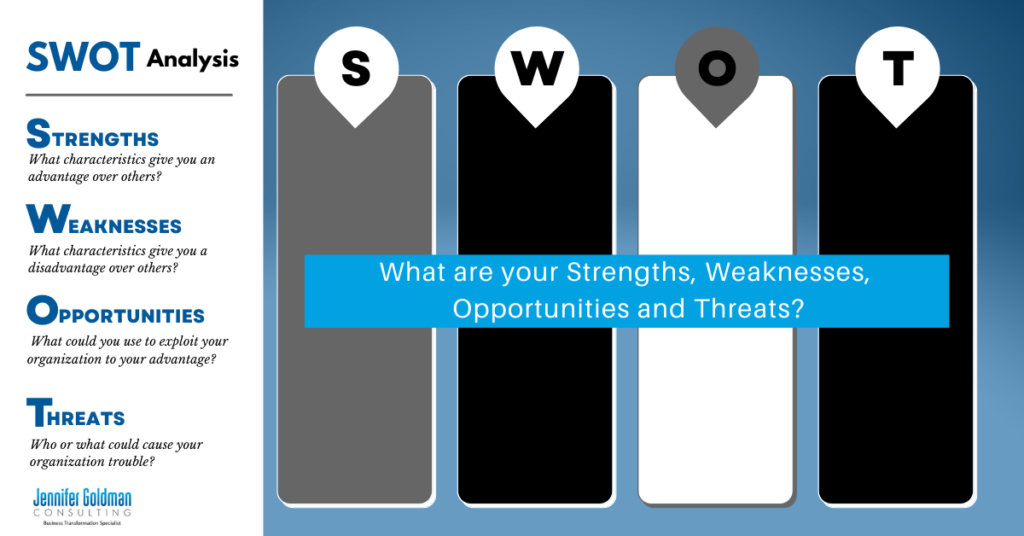
When you buy or sell a home, an inspection is usually one of the last steps in the process. However, the inspection often dictates whether or not a sale goes through. That’s a lot riding on just one step!
Before the sale went sour, it’s likely you knew some things needed to be addressed. If you’re selling, you probably knew that piece of siding needed repairing or the walls patched. If you are buying, you knew that broken appliances were a deal-breaker.
We all know that It is better to save money and time by uncovering what is needed BEFORE you start dreaming of receiving the sale proceeds or adding new décor to make the place your home.
A SWOT analysis works for your business just like an inspection does for a home. You take an in-depth observation of the business so you don’t waste time and money later.
What is a SWOT Analysis?
SWOT is a structured planning method to setting goals and efficiently evaluates: Strengths, Weaknesses, Opportunities, and Threats.
1. Strengths — What characteristics give you an advantage over others?
2. Weaknesses — What characteristics give you a disadvantage over others?
3. Opportunities — What could you use to exploit your organization to your advantage?
4. Threats — Who or what could cause your organization trouble?
How a SWOT Analysis Ensures Operational Excellence
It provides a crafting strategy
A crafting strategy lowers emotional reactions to issues and allows consideration of your audience and asks questions like: What do clients want? Have clients’ needs changed? How has technology impacted our field?
It considers internal and external aspects of the company
By considering strengths and weaknesses, you think about internal aspects of your firm. By thinking about opportunities and threats, you consider external issues.
It identifies potential and critical issues in your organization
By considering your firm and its landscape, you can address critical issues before they become real problems.
Practical Steps to Complete a SWOT Analysis
It doesn’t matter where you start with a SWOT analysis. You can start with the internal aspects or external issues. External threats, such as opportunities and threats, are outside of your direct control. Internal aspects, strengths and weaknesses, are in your control. Understandably, many businesses prefer to start with areas they can control and if so, it is wise to consider these areas of your business:
- Technology – List all your hardware, software, integrations and users. If you’ve adopted integrations, be sure your users are using them.
- Brand – Your brand should match the vision and marketing message you want to share with your consumers.
- Equity/ valuation – Run the numbers in Excel to see if you’re on a path to build equity and increase profitability.
- Core competencies and passion of your staff – You want the right people in the right roles. When you evaluate passion, you want to look for people who are interested in personal growth. These are people who have set goals for themselves. They also make excellent team members. They share knowledge, show respect, and accept criticism.
- Function chart of staff – Creating a chart will help ensure you have someone responsible for all the major areas of your operations and it will help make sure staff members are not overloaded with too many different functions.
- Competition and your traits – Compare your strengths and weaknesses to your competition’s.
Now What?
Document your key takeaways — the potential and critical issues — on a shared planning board for your team to view and digest at their own pace. Encourage your team (and self) to ideate potential solutions to items that pose as a threat to business growth and sustainability. And in your next company meeting, thank the SWOT analyzers for their time and energy to speak the truth. Finally, revisit these takeaways and solutions in your quarterly meetings so they stay top of mind and progress is celebrated.
Managing a growing business is a marathon, not a sprint, so lace up, adopt SWOT, and enjoy the results!






